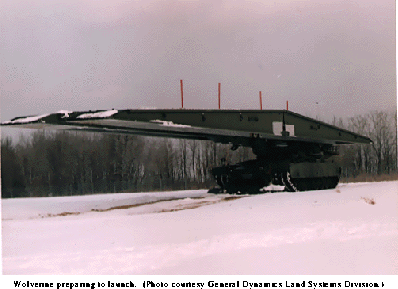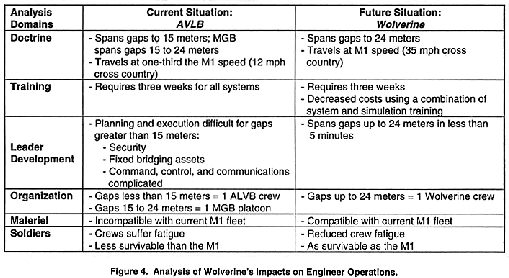By Major Harry Greene
The activities of engineers in the breach have been described as "an orchestrated ballet of farm implements."1 The capability of engineers to provide responsive mobility support to the heavy division is a well-known area of concern. The Engineer Regiment's top two materiel development priorities, the Grizzly and the Wolverine, are designed to alleviate those concerns. The following scenario contrasts the "orchestrated ballet" of today to the future of the regiment with the Grizzly and the Wolverine.
Circa 2006
The 1st Brigade of the 8th Infantry Division (Mechanized), supported by the 21st Engineer Battalion, is conducting a deliberate attack. LTC Castle, commander of the 21st Engineers, begins to daydream as he watches the plan unfold on the digital display in his command vehicle. He is comparing today's plan with one he executed 10 years before as a captain.
Circa 1996
The brigade was conducting a deliberate attack followed by a pursuit. The initial penetration had gone well and the brigade was on the march. A Company, commanded by CPT Castle, was supporting one of the lead task forces. Two bridges were ahead, but one was only military load class (MLC) 50 and the other spanned a 20-meter gap. Bypasses of both bridges were not available. The plan called for an armored vehicle-launched bridge (AVLB) to replace the MLC 50 bridge and a medium-girder bridge (MGB) to replace the 20-meter bridge if it was damaged.
The AVLB. As usual, the enemy didn't cooperate. He quickly disengaged and fell back to the far side of the first gap. The assault and obstacle platoon leader led the AVLB launcher forward. The platoon leader and the AVLB crew tried but could not keep up with the armored task force. The task force had to wait at the gap for the AVLB to catch up. Then they emplaced the bridge.
Since the M1 tanks exceeded the rated capacity of the bridge, crossings were caution crossings and the lieutenant became a bridge inspector. Meanwhile, the enemy was busy developing a complex obstacle in the path of the brigade's advance, using mine layers, ditching machines, and wire. The breach would be a difficult mission resembling "an orchestrated ballet of farm implements."
Scouts quickly found the minefield, the wire, and the tank ditch. The lead task force organized to conduct an in-stride breach. The support team began to suppress the site, while artillery and tanks provided smoke. After the security was set, an M1 with a mine roller began the breach by moving forward. When the roller encountered a mine, the M1 stopped and backed out. A combat engineer vehicle (CEV), on one of its last missions before retirement, pulled a mine-clearing line charge (MICLIC) forward and fired it. Another M1 with a track-width mine plow proofed the lane created by the MICLIC and then moved aside. A squad of sappers in an M113 armored personnel carrier came forward to breach the wire. The M113 moved aside, and an armored combat earthmover (ACE) attacked the tank ditch. Meanwhile, the support force was rapidly running out of direct-fire ammunition. Artillery continued to fire, but the fight was beginning to take its toll on the support force. The task force commander tried to see through the smoke to determine the progress of the various parts of the ballet. After the ACE cleared the tank ditch, the assault force began to pour through the obstacle. It hadn't been pretty, but good training and hard work got the task force through in true ESSAYONS spirit.
The MGB. CPT Castle hoped the toughest part of his day was over, but it wasn't. The lead team radioed back that the 20-meter bridge was out. CPT Castle had planned for this eventuality, but the MGB company was still a few hours away. When the company arrived, the soldiers did their best, but the enemy rained artillery fire on the unprotected combat engineers building the bridge. They successfully completed the bridge but not without the loss of blood of some of the builders. The task force that followed CPT Castle passed lines, giving A Company a well-deserved rest.
Circa 2006
LTC Castle's thoughts returned to the present. Conditions certainly had improved in the last 10 years. Although the mission today was nearly identical, the ease and speed of execution were much different.
The MLC 50 bridge was not a problem. The Wolverines in his battalion could easily maintain the pace of the armored task force. Better yet, lieutenants did not have to be dedicated to keep track of them. The Wolverine was fully digitized. Not only did the crew get the same directional information as the Bradley and Abrams crews, but the engineer and maneuver force leaders could track their progress on digital map screens without any effort by the crew. The Wolverine made it to the site, received a digital command to emplace the bridge, laid the bridge, and sent a digital report that caused the bridge to show up on the task force's digital maps.
The complex obstacle was much easier to breach, too. The Grizzlies were already task organized with the breach force. The support force set the necessary conditions for the breach and then digitally tasked the A Company commander to send the Grizzlies into action. With a few keystrokes, the company commander ordered the mission. The Grizzlies moved forward, plowed through the minefield, and breached the wire with their blades. Meanwhile, the task force commander was receiving real-time feedback on his screen on the location and progress of the breach. After a Grizzly attacked the tank ditch with its arm, the breach site was shown on digital maps throughout the task force. Quickly, the task force was through the complex obstacle and on the move again.
The 20-meter gap was not a problem because the Wolverines traveling with the lead task force were easily able to bridge the gap and pass the task force. Using the under-armor launch capability and the short 5-minute launch time, the crew and task force had minimal exposure at the gap.
This scenario may sound like a pipe dream from the Engineer School, but it isn't. Both the Grizzly and the Wolverine are in development with operational prototypes undergoing testing. When fielded, these two systems will accomplish complex obstacle breaches similar to the one that required CPT Castle to synchronize the use of many different systems. The first Wolverine will be fielded in 2000 and the first Grizzly in 2003. Both of them will be fielded to heavy division and corps mechanized battalions with a basis of issue of four Grizzlies and four Wolverines per company. These systems will greatly increase combat engineers' ability to provide responsive mobility support to Force XXI.
The Grizzly: A Heavy Force Complex Obstacle Breacher


The Grizzly will be a fully digitized member of the Army of the 21st century with a situational awareness similar to that of the supported M1 tanks and M2 Bradley fighting vehicles. The Grizzly promises to provide the maneuver task force with a robust, survivable, and mobile breaching platform to use against wire, mines, tank ditches, and log cribs.
The Grizzly's utility was highlighted by simulation results comparing it-operating alone-to the numerous systems we use today. The simulated mission involved a brigade clearing a main supply route (MSR) (Figure 1).
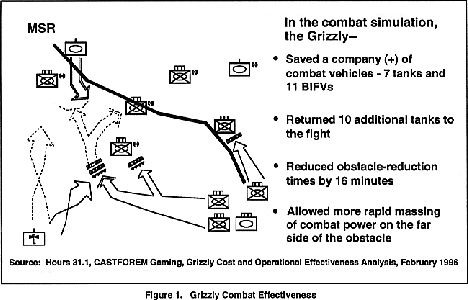
Using the Grizzly in this battle had a stunning impact. The main attack encountered a complex obstacle with mines, wire, and a tank ditch. The Grizzly breached this complex obstacle 16 minutes faster than the currently used equipment. As a result, the task force was able to mass combat power on the far side of the obstacle in less time, which saved a company (+) of combat vehicles. In addition, the Grizzly allowed 10 tanks equipped with breaching equipment (rollers and plows) to return to the fight rather than be committed to breaching duties. The simulation results make a strong case for the Grizzly requirement.
The Grizzly will also have a dramatic impact on engineer doctrine, training, leader development, organization, materiel, and soldiers (DTLOMS) as shown in Figure 2. Using the Grizzly-instead of the M1 with roller and track-width mine plow, the MICLIC, the ACE, and the AVLB-will greatly simplify our doctrine, training, and planning and execution of complex obstacle breaches. The Grizzly should ease the logistics burden by replacing engineer-unique platforms with the common M1 chassis. Finally, soldier survivability for both the supported task force and the engineer force will increase due to the Grizzly's faster breach times.
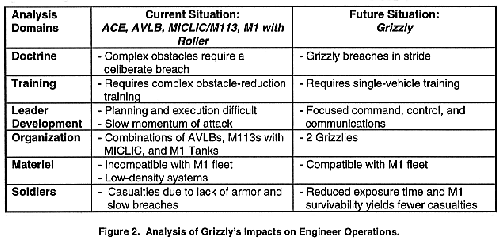
The Wolverine: A Heavy Force Assault Bridge
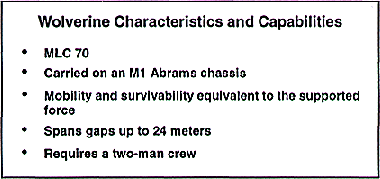
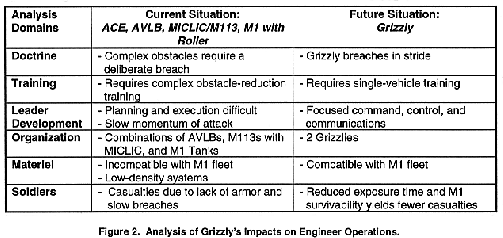
1

